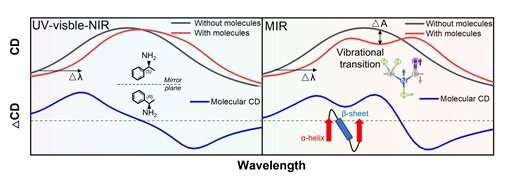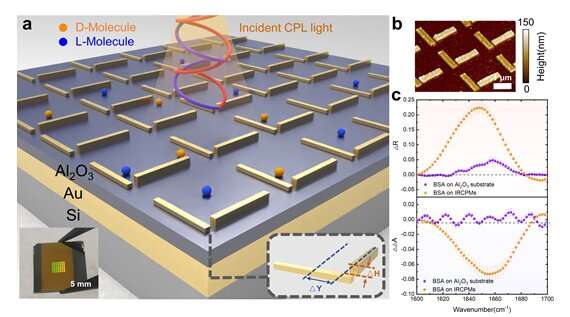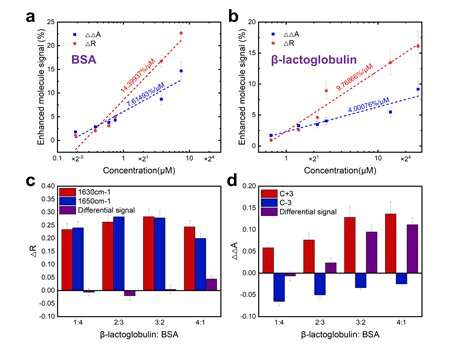This article has been reviewed according to Science X's editorial process and policies. Editors have highlighted the following attributes while ensuring the content's credibility:
fact-checked
peer-reviewed publication
trusted source
proofread
Surface-enhanced vibrational circular dichroism for chiral mixture sensing

Chiral molecules can present different chemical properties. For applications like drug delivery and diagnosis, it is important to detect chiral signals in mixtures. Although electronic circular dichroism (ECD) spectroscopy has been reported many times for sensing chiral molecules, it is still difficult to operate in chiral mixtures, as the dimensionality of the signals is limited.
Fortunately, expanding the wavelength to mid-infrared (MIR), the vibrational signals can be utilized to improve the dimensionality of molecular signals. However, the intrinsic VCD signal of molecules is very weak, around 3 magnitudes smaller than ECD signals. Hence, the potentiality of enhanced VCD spectroscopy is worth exploring.
In a new paper published in Light Science & Application, a team of scientists, led by Professor Chengkuo Lee from Center for Intelligent Sensors and MEMS (CISM), Department of Electrical and Computer Engineering, National University of Singapore, Singapore, has developed an infrared chiral plasmonic metamaterials (IRCPMs) based on perpendicular positioned nanorods with a metal-insulator-metal (MIM) structure as an enhanced VCD sensing platform. As gold on the bottom functions as a reflector, the incident light is either absorbed by the nanostructures or reflected to free space. Hence, by reading the reflection spectrum only, the absorption spectrum can be calculated accordingly.

The authors applied temporal coupled-mode theory to explain and optimize the chiral metamaterials and concluded that the two most significant factors that influence the VCD response are the near-field coupling strength and the loss ratios. Based on these calculation and simulation results, the authors broke both the in-plane and out-of-plane symmetries by varying the thickness and position of the nanorods, and experimentally validated their conclusion.
The optimized chiral metamaterial was then used for sensing demonstration. The authors coated protein samples that contain secondary structures onto the chiral metamaterials, and successfully obtained enhanced VCD signals of the amide I vibration peaks. They also measured the sensing performance of different concentrations and different mixture ratios. These results help quantify the limit of detection and sensitivity of this technology.

Summarizing their work, the authors state, "Our contribution is fourfold. Firstly, we develop an enhanced VCD sensing platform consisting of chiral metamaterials that achieves an enhancement of 6 magnitudes compared with traditional VCD spectroscopy. Secondly, we illustrate the methodology of design and optimization of MIR chiral metamaterials leveraging temporal coupled-mode theory, which indicates the importance of near-field coupling coefficient and loss ratios, leading to the design of both in-plane and out-of-plane symmetry-breaking dimensions. Thirdly, leveraging the mentioned sensing platform, we demonstrate the protein thin-film sensing process and achieve a lowest detection limit down to ~23 zeptomole level. Fourthly, we—for the first time—report the enhanced VCD sensing process for mixed protein secondary structures with high selectivity from vibrational transitions."
They conclude, "Benefiting from the high detectivity, low sample consumption, and feasible large-scale fabrication process, our IRCPM enables a promising chiral sensing platform for ultrasmall-volume sensing and label-free chiral mixture detection, which opens up a new avenue for chemical or biomedical applications such as the study and analysis of chiral nanostructures in dynamic reactions."
More information: Cheng Xu et al, Expanding chiral metamaterials for retrieving fingerprints via vibrational circular dichroism, Light: Science & Applications (2023). DOI: 10.1038/s41377-023-01186-3
Journal information: Light: Science & Applications
Provided by Chinese Academy of Sciences




















